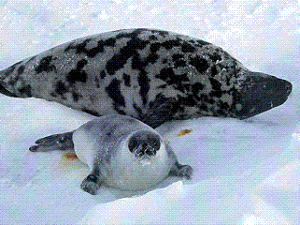 SKC Films Library SKC Films Library |
| SKC Films Library >> Science >> Zoology >> Mammals >> Order Carnivora >> Family Phocidae |
| Hooded Seal Cystophora cristata Description The hooded seal is light gray to blue-gray in color, with irregularly-shaped light or dark blotches. Males can be up to 8-1/2 feet long and weigh 660-900 pounds; females are much smaller. This seal gets its common name from an enlargement of the nasal cavity in males that resembles a hood. That "hood" can be inflated like a balloon to become as large as the seal's head. When not inflated, the "hood" hangs down over the upper lip. The male also has a bright red, membranous "balloon" inside one nostril (usually the left) that can be inflated. These "balloons" are inflated during displays of courtship, dominance, and threat. Distribution and Habitat Hooded seals are generally found in the far north Atlantic Ocean, from Greenland in the east to the Gulf of St. Lawrence in the west. When they are on land they usually occur in areas with significant ice cover or made up of ice packs. They migrate annually in order to stay in areas where there is drifting pack ice, and temporary populations have been seen as far west as Alaska, as far east as the Arctic waters off Scandinavia, and as far south as the Canary Islands and the Caribbean. After the breeding season, which usually runs from April-June, these seals travel long distances to feed. In June-August they reunite on the ice to molt, after which they disperse to feed until breeding season begins in late winter. Habits and Behaviors Hooded seals are very aggressive compared to other seals, and, unlike most other seals, largely solitary. Diet Like most other seals, the hooded seal feeds on a variety of fish, squid, octopi, and other marine invertebrates. They are capable of diving up to 3,000 feet in pursuit of food, and of staying submerged for as long as thirty minutes. Reproduction During the short time that the mother is giving birth and nursing her pup, several males will be in close proximity to her in order to obtain mating rights. At this time many males will aggressively threaten each other using their inflated nasal sac and even push each other out of the breeding area. Males do not typically defend personal territories, but will defend any area where there is a receptive female. A successful male will then mate with the female in the water. Once returning to land he will search for another female. Gestation takes about 11-1/2 months, after a delayed implantation period of up to 3-1/2 months. Unlike other seals, the fetus sheds its juvenile hair while still in the womb and is born with the thick hair common to adults. The pup is slate blue-gray pup is about 3 feet long and weighs about 50 pounds, and can move about and swim with ease from birth. The hooded seal has the shortest lactation of any mammal, with the pup being weaned at about 4 days. This short nursing period is possible because the milk of the female is rich in fat, which makes up about 60 to 70% of its content and allows the pup to double in size during its short nursing period. Once weaned, the pup is left to fend for itself. Females reach sexual maturity at about three years of age, males at about four years; the male will not develop his distinctive "hood" until reaching maturity. mother and juvenile hooded seals Scientific Classification phylum Chordata |
| SKC Films Library >> Science >> Zoology >> Mammals >> Order Carnivora
>> Family
Phocidae This page was last updated on June 12, 2017. |
